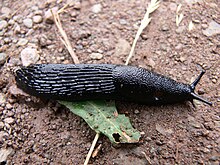Arion ater
| Black slug | |
|---|---|
 |
|
| A live and active individual of Arion ater | |
|
No special status
|
|
| Scientific classification | |
| Kingdom: | Animalia |
| Phylum: | Mollusca |
| Class: | Gastropoda |
| (unranked): |
clade Heterobranchia clade Euthyneura |
| Superfamily: | Arionoidea |
| Family: | Arionidae |
| Genus: | Arion |
| Species: | A. ater |
| Binomial name | |
|
Arion ater (Linnaeus, 1758) |
|
| Synonyms | |
|
Limax ater Linnaeus, 1758 |
|
clade Euthyneura
clade Panpulmonata
clade Eupulmonata
clade Stylommatophora
informal group Sigmurethra
Limax ater Linnaeus, 1758
Arion empiricorum Férussac, 1819
The black slug (also known as black arion, European black slug, or large black slug) Arion ater L. is a large terrestrial gastropod mollusk in the family Arionidae—the round back slugs. Land slugs lack shells like other terrestrial mollusks (such as snails). Without such shells, slugs produce unappetizing mucus—that may also contain toxins—to deter predators. Additionally, terrestrial slugs produce two other forms of mucus that facilitate locomotion and prevent death from drying. Such mollusks are hermaphroditic preferring to find mates. Slugs most often function as decomposers but are also often omnivores. Arion ater is one such slug, decomposing organic matter, preying on other organisms, and consuming vegetative matter—including agricultural crops. Native to Europe, the black slug is an invasive species in Australia, Canada (British Columbia, Newfoundland, Quebec), and the United States—Pacific Northwest.
Arion ater varies from 10–15 cm(3.9-5.9 in), reaching maturity at about 2.5 cm(1.0 in) and speed up to 4,5 cm/min or 2,54 m/h
The black slug is generally deep black, with some adults being brown or even white. Generally, pigmentation darkens directly with increasing latitude. Young specimens tend to be brown or ivory whitish, turning to grey before becoming characteristically black at maturity. Rust-brown individuals are arguably classified as a separate species Arion rufus (Red Slug). And the two can only be distinguished by dissecting the reproductive anatomy.
The following can identify Arion ater. The foot-fringe is black. The tubercles are large and elongate. The sole is blackish grey. The atrium and vagina (genitalia) are considerably narrower than is the spermatheca (organ for storing sperm). The oviduct is narrow while the spermatheca is spherical.
...
Wikipedia
